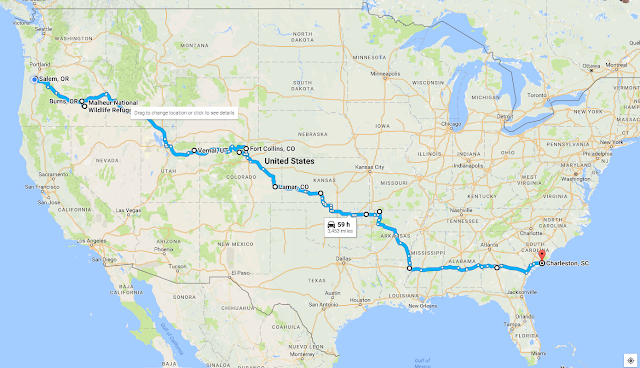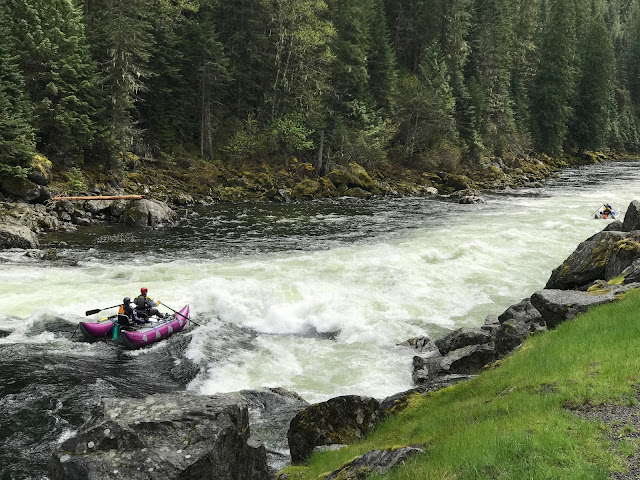Day 29 - 5/2/2017 - 8,404 miles to Salem, Oregon
We're home.
 |
| Eastward Journey |
The trip odometer tells us that we covered 8,404 miles in our little excursion. Across and back. One small rock chip on the windshield, patched in Atlanta. One stop by a cop for speeding in a tiny town in rural Idaho on day 27, with only a verbal warning.
Thousands of memories.
Would we do it again? You bet. We both agree it was a wonderful trip. Genial people the entire way.
Thirty different states, and the District of Columbia, in the following order:
Oregon, Idaho, Utah, Colorado, Kansas, Oklahoma, Arkansas, Louisiana, Mississippi, Alabama, Georgia, South Carolina, [back to Georgia, Atlanta], North Carolina, Tennessee, Virginia, District of Columbia, Maryland, Pennsylvania, West Virginia, Kentucky, Indiana, Illinois, Missouri, Iowa, Nebraska, South Dakota, Wyoming, Montana, [back through Idaho], Washington, and home to Oregon.
I called this blog Red States Driving because that is what we were going to see. The conservative parts of the country, at ground level, to reconnect with what we and most of our friends see as the "other" America.
Every part of America has a long and complicated story to tell. Our route bore us through what I see as the fundamental conflicts that have been in America since it's founding. Political power within the concept of democratic government, and race: The Civil War, African American and Native American subjugation.
You can only see so much, even when you drive. We stuck to the smaller roads to a great extent to see the smaller towns of America. What we saw was mixed.
Most places appear to be OK. Some, are clearly prosperous. Others a few miles away, not as much. For the small towns of the plains farm states, there are often vacant storefronts, but the surrounding farms often look great; new paint and pickup trucks. well tended fields and livestock. But in every small town we went, if it wasn't a tourist mecca, you rarely saw anyone in the streets no matter the time of day.
I strongly suspect that the consolidation of small family farms found in the 60's into much larger and more highly mechanized family farms results in not enough people to support a community. That peak population they had decades ago built an infrastructure not fully needed now. Fewer people, fewer stores needed.
In a couple of cases, it looked like people had to drive 10 to 20 miles to buy groceries, which they must be doing.
Are those towns dying? We talk about that because of the change we see. Another way to see it is that they are merely shrinking to face reality. What new economics can make them grow? I have no answer.
Vickie noticed as we drove through the deep south that we didn't see any blacks in most of the rural towns.We saw blacks in the cities, but rarely in the countryside. The exceptions were in Northeast Louisiana and in Mississippi where there were clearly black small towns. They also appeared to be the most destitute towns we saw. Georgia clearly had some black towns like Selma that are struggling, but not as destitute.
A rule of thumb seems to be that size matters. The larger the town, the more prosperous. It's not always true, however. We drove through a part of Jackson, Mississippi, that was decidedly not prosperous and many streets were awful and had been for decades. And Jackson is the state capitol.
What everything had in abundance was the beauty of the countryside. Everywhere we went the landscape enchanted.
The culture in much of rural America is quietude. Even on a Friday or Saturday night the small towns are mostly closed. We rarely saw teens; a couple hanging around outside a mini-mart smoking cigarettes was about it. A few cars in front of a local bar, but quiet. Residential neighborhoods with the flicker of a TV or soft lights visible through curtains, or dark and already in bed. Few porchlights. Quietude.
Far different from the hustle and bustle of medium or bigger cities, where cars are coming and going and business are open. Vibrance.
In all places, and even more so the farther south and east you went, were the signs of religion. 24 hour Christian radio and TV shows Numerous churches, but most fairly small. Some thriving, some no so much. Fox news was clearly a favored choice everywhere we went..
One thing that caught my attention was in North Carolina and Virginia where farm after farm sprouted their own private Calvary's: Three closely spaced crosses, usually on the crest of a rise. I saw church signs with the same symbolism, but forget the denomination. Clearly these folks seek to make a bold and open declaration of their faith. I was raised a Roman Catholic, now an atheist, and always taught to be proud of your religion, But such public displays were mainly for the Christmas season.
The cultural differences between rural and urban Americans is probably more divided than ever. My sense is that rural folks, in declining areas, see the predominant urban culture that saturates all media as a real and clear threat. It's a real and clear threat because their lifestyle is fading.
Our nation is locked in that cultural struggle. Conservatives are now solidly locked into an attempt to regain the past. Forced adherence to a narrowly defined set of fundamentalist religious principles. Rejection of science if it is inconvenient to personal desires. Forced adherence by those that are different in religion, ethnic identity, and sexual orientation to the demands of those in power. Adherence to "conservative" economic principles, but which are routinely ignored once power is gained.
At the start of this country only white male landowners could vote. The great stains of America are rooted in discrimination. The keeping of "others" from partaking in the running of the country. Slavery, Genocide against Native American tribes. Denial of rights to Women, Asians, Italians, Irish, Jews and more. Segregation, Lynchings. Poll Taxes. Even the murder of children in church. These are all part of the heritage we bear, and must resist.
Thousands of memories.
Would we do it again? You bet. We both agree it was a wonderful trip. Genial people the entire way.
Thirty different states, and the District of Columbia, in the following order:
Oregon, Idaho, Utah, Colorado, Kansas, Oklahoma, Arkansas, Louisiana, Mississippi, Alabama, Georgia, South Carolina, [back to Georgia, Atlanta], North Carolina, Tennessee, Virginia, District of Columbia, Maryland, Pennsylvania, West Virginia, Kentucky, Indiana, Illinois, Missouri, Iowa, Nebraska, South Dakota, Wyoming, Montana, [back through Idaho], Washington, and home to Oregon.
 |
| Return Leg 1 |
 |
| Final Leg Home |
Every part of America has a long and complicated story to tell. Our route bore us through what I see as the fundamental conflicts that have been in America since it's founding. Political power within the concept of democratic government, and race: The Civil War, African American and Native American subjugation.
You can only see so much, even when you drive. We stuck to the smaller roads to a great extent to see the smaller towns of America. What we saw was mixed.
Most places appear to be OK. Some, are clearly prosperous. Others a few miles away, not as much. For the small towns of the plains farm states, there are often vacant storefronts, but the surrounding farms often look great; new paint and pickup trucks. well tended fields and livestock. But in every small town we went, if it wasn't a tourist mecca, you rarely saw anyone in the streets no matter the time of day.
I strongly suspect that the consolidation of small family farms found in the 60's into much larger and more highly mechanized family farms results in not enough people to support a community. That peak population they had decades ago built an infrastructure not fully needed now. Fewer people, fewer stores needed.
In a couple of cases, it looked like people had to drive 10 to 20 miles to buy groceries, which they must be doing.
Are those towns dying? We talk about that because of the change we see. Another way to see it is that they are merely shrinking to face reality. What new economics can make them grow? I have no answer.
Vickie noticed as we drove through the deep south that we didn't see any blacks in most of the rural towns.We saw blacks in the cities, but rarely in the countryside. The exceptions were in Northeast Louisiana and in Mississippi where there were clearly black small towns. They also appeared to be the most destitute towns we saw. Georgia clearly had some black towns like Selma that are struggling, but not as destitute.
A rule of thumb seems to be that size matters. The larger the town, the more prosperous. It's not always true, however. We drove through a part of Jackson, Mississippi, that was decidedly not prosperous and many streets were awful and had been for decades. And Jackson is the state capitol.
What everything had in abundance was the beauty of the countryside. Everywhere we went the landscape enchanted.
The culture in much of rural America is quietude. Even on a Friday or Saturday night the small towns are mostly closed. We rarely saw teens; a couple hanging around outside a mini-mart smoking cigarettes was about it. A few cars in front of a local bar, but quiet. Residential neighborhoods with the flicker of a TV or soft lights visible through curtains, or dark and already in bed. Few porchlights. Quietude.
Far different from the hustle and bustle of medium or bigger cities, where cars are coming and going and business are open. Vibrance.
In all places, and even more so the farther south and east you went, were the signs of religion. 24 hour Christian radio and TV shows Numerous churches, but most fairly small. Some thriving, some no so much. Fox news was clearly a favored choice everywhere we went..
One thing that caught my attention was in North Carolina and Virginia where farm after farm sprouted their own private Calvary's: Three closely spaced crosses, usually on the crest of a rise. I saw church signs with the same symbolism, but forget the denomination. Clearly these folks seek to make a bold and open declaration of their faith. I was raised a Roman Catholic, now an atheist, and always taught to be proud of your religion, But such public displays were mainly for the Christmas season.
The cultural differences between rural and urban Americans is probably more divided than ever. My sense is that rural folks, in declining areas, see the predominant urban culture that saturates all media as a real and clear threat. It's a real and clear threat because their lifestyle is fading.
Our nation is locked in that cultural struggle. Conservatives are now solidly locked into an attempt to regain the past. Forced adherence to a narrowly defined set of fundamentalist religious principles. Rejection of science if it is inconvenient to personal desires. Forced adherence by those that are different in religion, ethnic identity, and sexual orientation to the demands of those in power. Adherence to "conservative" economic principles, but which are routinely ignored once power is gained.
At the start of this country only white male landowners could vote. The great stains of America are rooted in discrimination. The keeping of "others" from partaking in the running of the country. Slavery, Genocide against Native American tribes. Denial of rights to Women, Asians, Italians, Irish, Jews and more. Segregation, Lynchings. Poll Taxes. Even the murder of children in church. These are all part of the heritage we bear, and must resist.






Comments
Post a Comment